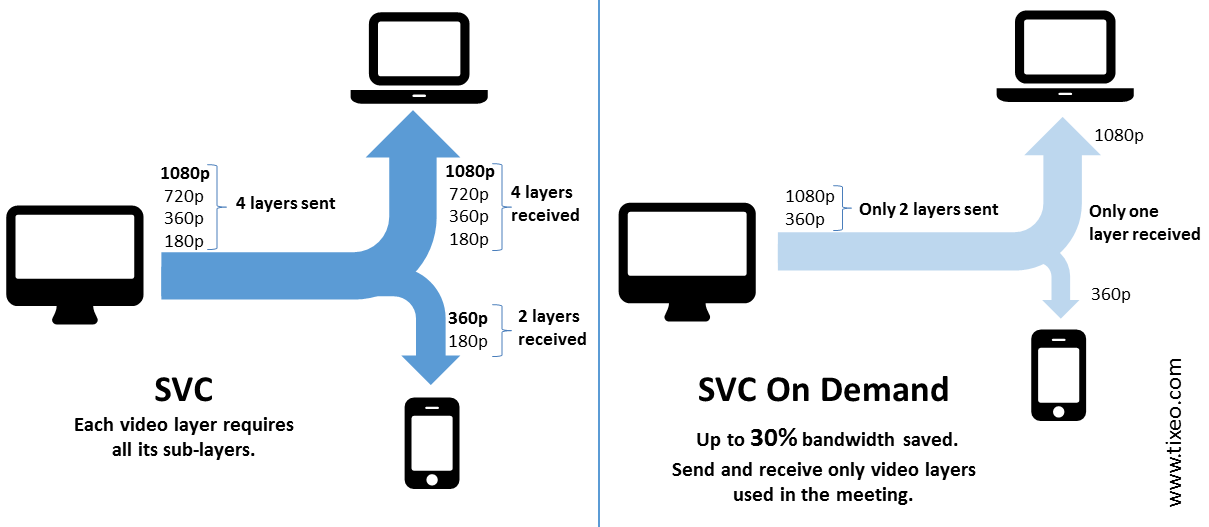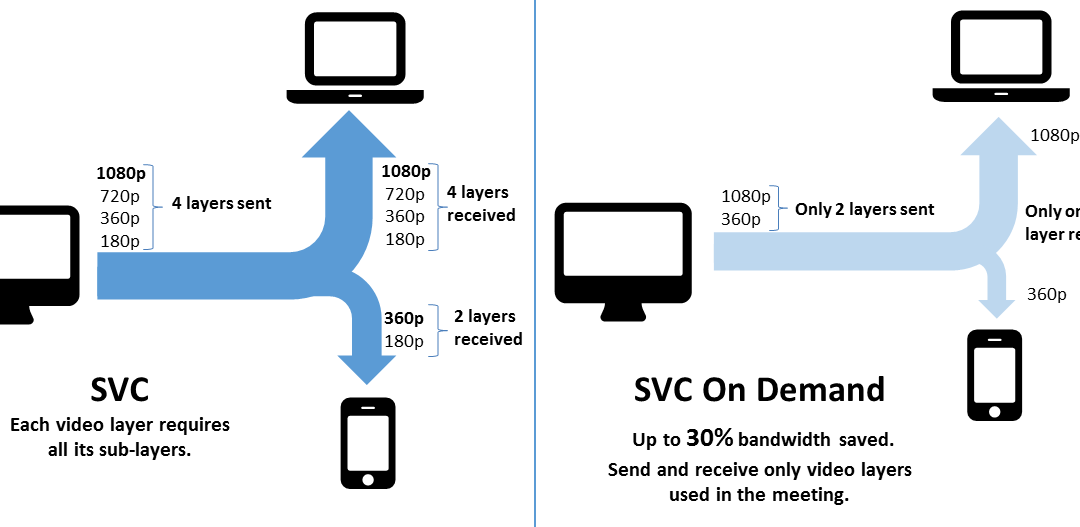The release of Tixeo v7 comes with a whole new audio and video “stack” with many innovations, including the “SVC on Demand” technology pushing the limits of video conferencing.
“The Holy Grail of video conferencing” smaller video streams for higher quality
To clearly understand the technological step ahead of Tixeo, it is important to have a quick look at the two existing architectures for adaptive multipoint video conferencing :
MCU (Multipoint Control Unit) :
This technology consists in mixing all the video streams received from the participants and send the mixed video stream back to each. It has been used for ages by legacy video conferencing players (Polycom, Cisco, Lifesize…). The H.264 AVC video codec is the most commonly used in these systems.
Pros:
- Each participant only receives one video stream adapted to the network
Cons:
- A high CPU usage (decoding, mixing and re-encoding), often requiring hardware acceleration
- Low scalability
- Introduces a delay in communication due to high processing load
- Quality loss result of the decoding and re-encoding of the video streams
Media relay server : Unlike the MCU, this technology (eg Vidyo) performs no mixing, decoding and re-encoding server side. It is thanks to the properties of the H.264 SVC (Scalable Video Coding) codec that the video streams can be adapted to the receiver’s capacity. Indeed, an SVC video stream contains multiple stacked layers, each representing a different level of quality. Each participant receives as many streams as participants in the meeting and not just one mixed stream with all videos like with an “MCU”.
Pros :
- Low server-side CPU usage (simple video stream filtering)
- No delay added to communication
- A good adaptation of video streams to the network capacity
- Good scalability
- No loss of quality due to a re-encoding of the video stream
Cons :
- For the same video resolution, an H.264 SVC stream can use up to 20% more bandwidth than an H.264 AVC stream
- The complexity of H.264 SVC codec induces a higher CPU usage client-side
“SVC on Demand”: 10-30% bandwidth saved
Tixeo’s “SVC on Demand” (SVCoD) is a strange creature. It keeps all the advantages of the media relay server architecture, but without the drawbacks. The innovation consists in taking into account the context of the meeting in the encoding strategy. Each client will encode its video stream according to each of the other participants, their network capacity, their equipments and their display resolution.
Indeed, each participant simply sends the video layers needed in a meeting. Tixeo therefore removes any bandwidth overconsumption added by a classic SVC codec.
Consider the case of a call between an HD room, a desktop and a smartphone. With SVCoD, only two video “layers” are used, corresponding to resolutions of the desktop and the smartphone.
The result is simply a higher image quality for a lower bandwidth usage.

Max motion
Completely related to its new SVCoD technology, Tixeo introduced “Max motion”, a technology using at all times the maximum frame rate provided by the camera.
Tixeo favors a maximum smoothness, your camera supporting 30 or even 60 frames per second, even in case of network slowdown.
New audio stack: Crystal-clear voice in all circumstances
All the studies converge, a good video quality is perceived only if the sound quality is perfect. This is why Tixeo has completely rewritten its audio stack. It now integrates the best audio codec know at this day for communication over the Internet: OPUS. It allows having a lower network usage while significantly increasing the quality, which will remain optimal whatever the type of sound (voice or music) sent.
This new “stack” also contains a more powerful echo canceller, ensuring meetings without any echo whatever the conditions of use.
Multipoint video conferencing: always highly secured
It is important to remind that the confidentiality of shared information is secured by streams encryption. Tixeo’s solution neither requires opening network ports (HTTPS Tunneling), nor changing the security policy of the company, unlike all known SIP or h.323 solutions.

